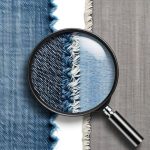Are you unsure if that sweater you just bought is made of real wool? Don’t worry, we’ve got you covered.
In this article, we’ll show you how to confidently identify wool fabric. By understanding the characteristics, texture, and weave of wool fabric, as well as recognizing different types of wool fibers, you’ll be able to determine its authenticity.
We’ll also share tips on how to spot fake or imitation wool fabric.
Get ready to become a wool fabric expert!
Table of Contents
Understanding the Characteristics of Wool Fabric
To understand the characteristics of wool fabric, you’ll need to familiarize yourself with its unique properties. Wool is known for its exceptional durability, making it a popular choice for clothing and textiles. When evaluating the durability of wool fabric, consider its ability to resist wear and tear, as well as its resilience to stretching and shrinking. Wool is also naturally flame-resistant, making it a safe option for various applications.
Understanding the care instructions for wool fabric is essential to maintain its quality and prolong its lifespan. Wool has a tendency to shrink if not properly cared for, so it’s important to follow the recommended care instructions. Most wool garments require hand washing or dry cleaning to prevent damage. Avoid using hot water, harsh detergents, or excessive agitation when washing wool items. Instead, use a gentle detergent specifically formulated for wool and soak the garment in lukewarm water before carefully rinsing and laying it flat to dry.
Evaluating the Texture and Feel of Wool Fabric
When evaluating the texture and feel of wool, it’s important to use your hands to assess its softness and thickness. Wool should feel soft and luxurious to the touch, with a slightly fuzzy surface. Run your fingers through the fabric and pay attention to how it feels against your skin. Authentic wool will have a natural warmth and insulation, making it perfect for colder seasons.
To evaluate the quality of wool, look for a dense and tightly woven fabric. The thickness of the fibers should be uniform throughout, with no thin or sparse areas. Gently squeeze the fabric to feel its resilience and elasticity. High-quality wool will bounce back quickly when released, while lower-quality wool may feel flat and lack bounce.
Another important aspect to consider when identifying the authenticity of wool is the presence of lanolin. Lanolin is a natural oil that is produced by sheep and is often retained in wool fibers. Rub a small area of the fabric between your fingers, and if you feel a slight greasiness or moisture, it indicates the presence of lanolin and confirms that the fabric is made of authentic wool.
Examining the Weave and Structure of Wool Fabric
Examining the weave and structure of wool, you can determine the quality by looking for a tightly woven fabric with consistent thickness and no irregularities. When evaluating the color and appearance of wool fabric, it is important to note that high-quality wool tends to have a vibrant and uniform color. You should check for any discoloration, fading, or uneven dyeing. Additionally, take note of any visible fibers or lint on the surface of the fabric, as this can indicate a lower quality wool.
Determining the weight and thickness of wool fabric is another important aspect of evaluating its quality. A good quality wool fabric should have a substantial weight, indicating a denser and more durable material. However, it is also essential to consider the intended use of the fabric, as some applications may require lighter weights.
When examining the thickness of wool fabric, you should look for consistency throughout. The fabric should not have any thin or thinning areas, as this can affect its overall strength and longevity. It is also worth noting that wool fabric with a tighter weave generally tends to be of higher quality.
Identifying Natural and Synthetic Wool Blends
Natural and synthetic wool blends can be distinguished by their texture and performance characteristics. When evaluating durability, it is important to consider the wool content of the blend. Natural wool blends tend to be more durable than synthetic blends. They are known for their ability to withstand wear and tear, making them ideal for long-lasting garments and upholstery. Synthetic wool blends, on the other hand, may not be as resilient and may show signs of wear more quickly.
To determine the wool content of a blend, you can perform a simple burn test. Take a small piece of the fabric and hold it over a flame. Natural wool will smell like burning hair, while synthetic fibers will produce a plastic-like smell. Be cautious when conducting this test and ensure you have proper ventilation.
Another way to determine the wool content is by examining the texture of the fabric. Natural wool has a unique crimped texture, which gives it a soft and fluffy feel. Synthetic blends may feel more smooth and uniform.
Recognizing Different Types of Wool Fibers
One way to recognize different types of wool fibers is by their unique textures and appearances. Here are three key factors to consider when evaluating wool quality and identifying wool grades:
-
Fiber Diameter: Wool fibers can vary in diameter, which affects their softness and durability. Fine wool fibers, with a diameter of 18 microns or less, are considered high quality and are often used in luxury garments. On the other hand, coarser wool fibers, with a diameter of 30 microns or more, are typically used in more durable products like blankets.
-
Crimp: Wool fibers have a natural wave pattern called crimp. The presence of strong, well-defined crimp indicates high-quality wool. The crimp allows the fibers to interlock, creating warmth and elasticity in the fabric. Fabrics with less crimp tend to be less resilient and may lack the desirable characteristics of wool.
-
Sheen and Luster: High-quality wool fibers often have a natural sheen and luster. This shine is a result of the wool’s ability to reflect light. Fabrics with a noticeable sheen are typically more luxurious and visually appealing.
Conducting the Burn Test to Determine Wool Content
When conducting the burn test to determine wool content, it’s important to understand the accuracy of this method. Differentiating between wool and synthetic fibers can be challenging, but there are key differences to look for.
Safety precautions should always be taken when burning fabrics, as this process involves open flames.
Burn Test Accuracy
The burn test can be accurate in determining the fabric composition. By following the burn test procedure and interpreting the burn test results, you can gain valuable insights into the fabric you are testing.
Here’s how you can ensure accuracy:
- Conduct the burn test in a controlled environment, away from flammable materials, to ensure safety and accurate results.
- Use a small sample of fabric and ignite it with a lighter or match.
- Observe the flame, smell, and ash produced during the burn test.
Interpreting the burn test results is crucial to accurately determining the fabric composition. Wool fabric will burn slowly, with a smoldering flame and a strong odor of burning hair. The ash produced will be powdery and grayish-black in color.
Wool Vs Synthetic Differences
To accurately distinguish between wool and synthetic fabrics, pay attention to the burn test results and note the differences in flame behavior and odor. Wool is a natural fiber derived from sheep, while synthetic fabrics like polyester are man-made. When conducting a burn test, wool will typically burn slowly with a smoldering flame, emitting a smell similar to burning hair or feathers. On the other hand, synthetic fabrics like polyester will melt and burn quickly with a bright flame, producing a chemical odor. Here is a comparison table to help you understand the differences between wool and polyester:
| Wool | Polyester | |
|---|---|---|
| Source | Natural fiber from sheep | Man-made synthetic fabric |
| Burn Behavior | Burns slowly with a smoldering flame | Melts and burns quickly with a bright flame |
| Odor | Smells like burning hair or feathers | Produces a chemical odor |
Safety Precautions When Burning
Make sure you take necessary safety precautions before conducting a burn test, such as wearing protective gloves and eyewear. Safety is paramount when it comes to burn tests.
To ensure you stay safe during the process, it is important to follow proper burning technique. Start by cutting a small piece of fabric, about an inch in length. Hold the fabric with a pair of tweezers or pliers, keeping it away from your body and any flammable materials.
Use a lighter or a match to ignite the fabric, observing the flame and the odor it produces. Remember to conduct the burn test in a well-ventilated area to avoid inhaling any fumes.
Tips for Spotting Fake or Imitation Wool Fabric
When it comes to spotting fake or imitation wool fabric, two key points to consider are texture and softness. Real wool fabric tends to have a unique texture that is slightly rough and coarse, while fake wool fabric may feel smoother and softer to the touch.
Another method to determine the authenticity of wool fabric is the burn test. By carefully burning a small piece of the fabric and observing the resulting ash, smell, and behavior, you can gain valuable insights into its composition.
Texture and Softness
The texture and softness of wool fabric can vary depending on the type of wool used. Wool fabric is known for its unique texture and softness, making it a popular choice for clothing and home décor items.
When analyzing the texture of wool fabric, pay attention to the following factors:
- Fiber length: Longer fibers tend to result in a softer and smoother texture.
- Micron count: Lower micron count indicates finer wool and a softer feel.
- Weave: Different weaving techniques can affect the texture, from dense and smooth to loose and fluffy.
- Finishing treatments: Some wool fabrics undergo special treatments to enhance their softness and texture.
- Blends: Wool can be blended with other fibers, such as cashmere or silk, which can influence the overall texture and softness.
Burn Test Method
Now that you have learned about the texture and softness of wool fabric, let’s dive into another reliable method to identify it: the burn test.
This method involves carefully burning a small piece of the fabric and observing its behavior. Wool fabric has distinct characteristics when it burns, such as a smell of burning hair and a slow, self-extinguishing flame.
However, it is important to note that the burn test may not be foolproof and can be dangerous if not done correctly. Therefore, it is recommended to use alternative fabric identification methods, such as examining the fabric’s label or consulting a professional.
These methods provide more reliable and safe ways to identify wool fabric without the risk of fire or inaccurate results.
Conclusion
In conclusion, identifying wool fabric can be done by understanding its characteristics, evaluating its texture and feel, examining its weave and structure, and recognizing different types of wool fibers.
Additionally, conducting a burn test can help determine the wool content of a fabric. It’s important to be aware of fake or imitation wool fabric and to know the tips for spotting them.
By following these steps, you can confidently identify wool fabric and make informed decisions when purchasing or working with it.
- The Use of Nonwovens in Construction and Civil Engineering - July 11, 2025
- The Use of Nonwovens in Construction and Civil Engineering - July 11, 2025
- The Use of Nonwovens in Construction and Civil Engineering - July 11, 2025





